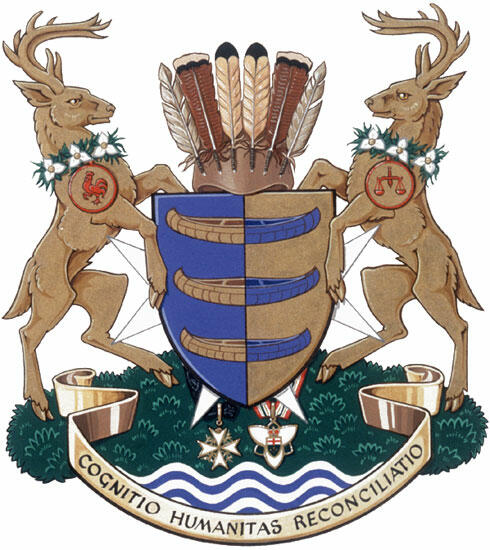The contents of this Register are intended for research purposes only. The heraldic emblems found in the Register may not be reproduced in any form or in any media without the written consent of the Canadian Heraldic Authority and/or the recipient.
Toronto, Ontario
Grant of Arms and Supporters
September 16, 2002
Vol. IV, p. 236
Arms of James Karl BartlemanBlazonPer pale Azure and Or three Ojibway canoes in pale counterchanged;
SymbolismThe symbolism is multiple. First, the colour choice was the preference expressed by His Honour. Second, the division into the two colours symbolizes the union between His Honour and Her Honour. Third, the three canoes represent Their Honours' three children. Fourth, they also represent an element of His Honour's First Nations heritage. Fifth, the canoes can refer to the notion of diplomacy and travelling to other lands to undertake diplomatic work.
|
MottoBlazonCOGNITIO HUMANITAS RECONCILIATIO; SymbolismThis is a statement of important elements in His Honour's personal philosophy. It means "Knowledge, understanding, reconciliation". |
SupportersBlazonTwo white-tailed deer Or each gorged with a collar of trillium flowers and sweet grass proper pendent therefrom a bezant fimbriated, that to the dexter charged with a cock, that to the sinister charged with a balance Gules, the supporters standing on a grassy mound Vert above barry wavy Argent and Azure; SymbolismThe grass symbolizes the lawns of Queen's Park, the site of the Lieutenant Governor's suite. The wavy white and blue bands represent the waters of the lakes of Muskoka. The white-tailed deer are His Honour's family symbol. The trillium, Ontario's provincial flower, represents His Honour's service to the province as Lieutenant Governor. The sweetgrass is a reference to the ceremonies that frequently precede important First Nations gatherings and is thus another reference to His Honour's heritage. By extension, it can also symbolize the formal discussions and interchange of diplomacy. The medallions feature a reference to Her Honour's heritage, the red cock of Wallonia, and a symbol honouring His Honour's father and Their Honours' son Laurent, pursuing a legal career. |
Additional InformationCreator(s)Original concept of Robert D. Watt, Chief Herald of Canada, assisted by the Heralds of the Canadian Heraldic Authority PainterLinda Nicholson CalligrapherSuzzann Wright Recipient TypeIndividual Special DesignationLieutenant Governor |




